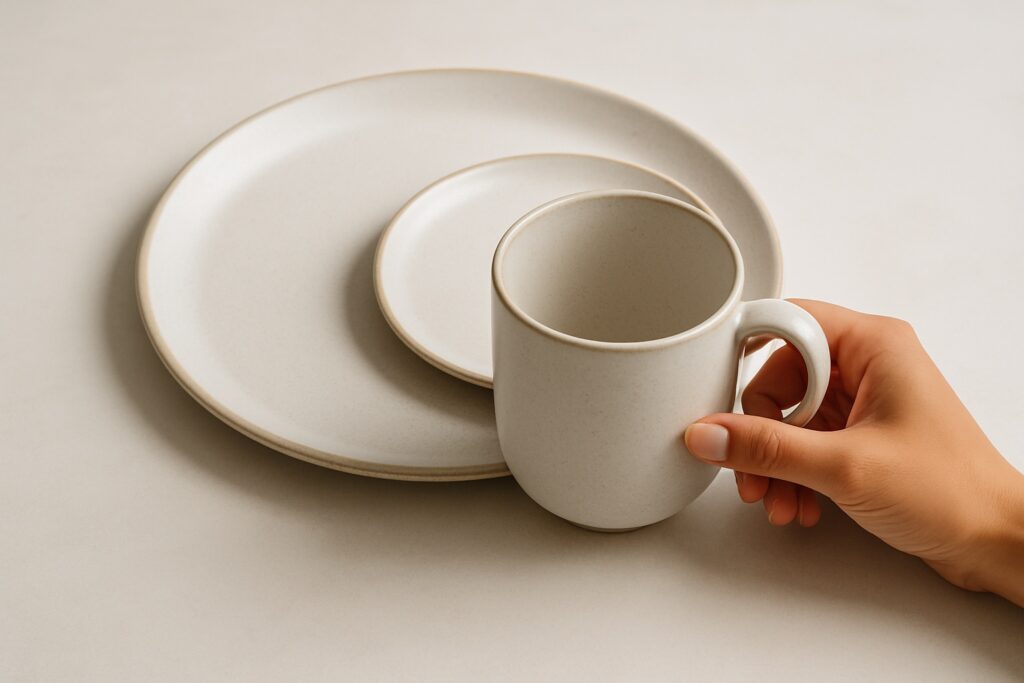Ceramic FAQ – 13 Essential Answers for Global Buyers
Welcome to Sharmeehouse’s Ceramic FAQ section. This page answers the 13 most frequently asked questions from our global B2B clients regarding custom ceramic and enamelware production. From materials and certifications to bulk order terms, logo customization, and global shipping, this ceramic FAQ helps streamline your sourcing decisions.

Ceramic FAQ Quick Navigation
Ceramic FAQ: Product & Technical Information
1. What materials are used in ceramic products?
Ceramic products are primarily made from reinforced porcelain and bone china—reinforced porcelain is a vitrified ceramic composed of kaolin, feldspar, and quartz, fired at high temperatures to achieve exceptional mechanical strength and thermal shock resistance, making it ideal for high-usage tableware in hospitality and foodservice environments; bone china, containing 30–50% bone ash along with kaolin and feldspar, is known for its lightweight structure, high whiteness, translucency, and refined surface, making it the preferred material for premium dinnerware, upscale gifts, and brand-enhancing ceramic collections.
2. What materials are used in enamel products?
Enamelware consists of a high-quality metal base—commonly steel, aluminum, or cast iron—coated with a layer of vitreous enamel. This enamel is a durable, glass-based glaze that is fused to the metal at high temperatures (typically over 800°C), creating a smooth, non-porous, and chemically resistant surface.
Sharmeehouse use enamel materials sourced from renowned Japanese manufacturer Tomatec, ensuring excellent quality and compliance with international standards. Our enamelware features a steel base with a thickness ranging from 0.5 mm to 0.8 mm, offering enhanced durability and heat resistance. The enamel coating not only provides vibrant color and a glossy finish but also protects the metal from corrosion, making it ideal for cookware, food containers, camping gear, and lifestyle products.
3. What are the differences between ceramic and enamel products?
Ceramic and enamel products differ significantly in material composition, manufacturing process, performance characteristics, and end-use scenarios: ceramic is crafted from natural clay and minerals through high-temperature kiln firing, offering a refined aesthetic but with a more brittle structure, whereas enamelware features a metal core—typically steel or cast iron—coated with a fused vitreous enamel glaze, resulting in enhanced durability, corrosion resistance, and impact tolerance.
4. How to maintain ceramic products?
To maintain ceramic products properly, clean them using warm water, a mild detergent, and a soft sponge—avoiding abrasive scrubbers or harsh chemicals that can damage the glaze. Prevent sudden temperature changes and handle with care to minimize impact-related chipping. Use padding between stacked items to avoid surface scratches.
5. How to maintain enamel products?
Rinse enamelware after use, clean with soft sponges, and avoid prolonged soaking. Prevent overheating and use non-metallic utensils. Store items separately or with padding to maintain the enamel coating and glossy finish.
6. How do I choose the right material for bulk ceramic or enamel sourcing?
Bone china is best for refined, elegant products like upscale gifts or restaurant ware. Enamelware is more durable and suitable for casual, lifestyle, and outdoor use. Choose based on your brand's aesthetic, end-use scenario, and durability needs.
7. Can ceramic and enamel products be customized with logos and colors?
Yes, both can be customized. Bone china requires design sensitivity due to translucency. Enamel surfaces support bolder, more vibrant branding due to their opacity and surface durability.
8. Is your ceramic factory certified to meet international compliance standards?
Yes. Our facilities are FAMA approved, BSCI-audited, and certified for FDA and LFGB compliance, ensuring our ceramic products are safe for food contact in the U.S., EU, and Japan.
9. What is your defect rate control standard for ceramic shipments?
We maintain a 3% maximum defect rate per shipment, inspected under internal protocols and AQL standards. We also offer third-party inspections and tailored QC plans for OEM clients.
Ceramic FAQ: Ordering, Shipping & Business Services
10. What types of custom ceramic products does Sharmee House offer?
We offer B2B ceramic solutions including logo mugs, branded tableware, hospitality ceramics, and promotional gift items. OEM and white-label programs are available for restaurants, hotels, and global retailers.
11. How can I order custom mugs or branded tableware?
Email us at service@sharmeehouse.com with your requirements. We'll assist with design, sampling, production, and logistics for your bulk ceramic order.
12. Do you offer international shipping for ceramic products?
Yes, we ship worldwide. Freight is based on product type, quantity, and destination. Contact us with your project details for an exact quote.
13. Can I order a sample before placing a larger custom ceramic order?
Yes, samples are available for most designs to confirm product quality, glaze, and logo print clarity. MOQ for bulk production is 3,000 pieces per style.
Learn more about our ceramic product collections and our certified ceramic manufacturing process.